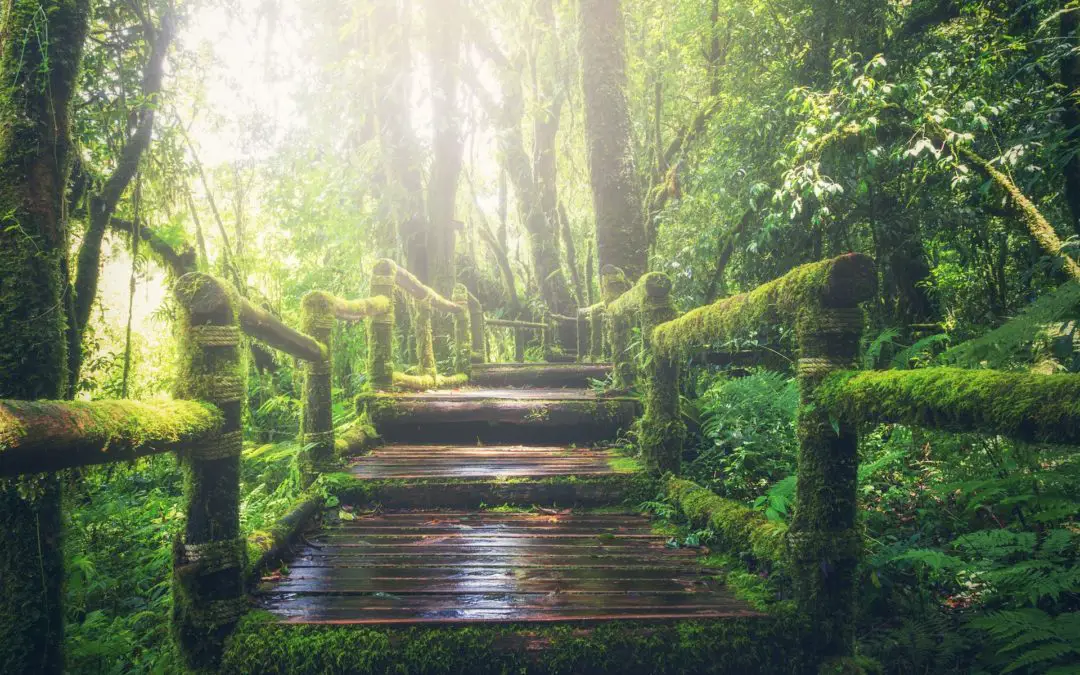A lot of plants want humidity levels that aren’t comfortable for humans, so we need some way of getting them what they need. Maybe you have crispy leaves, they’re turning brown or yellow, or maybe the plant’s starting to wilt. All of these can be signs of low humidity. Here are 25 ways you can increase humidity for your plants.
Install a furnace humidifier. This is the most expensive, but most solid plan. It will increase humidity in your whole house. Humidity in the 35-60% range is comfortable for humans, so if you need higher than this, you’ll want more focused humidity using one of the techniques below.
Use a portable humidifier. Portable humidifiers are small machines that you fill with water. They evaporate it into the air, usually with a wicking element and a fan.
Lower the thermostat, especially at night. Most plants can handle house temperature ranges wider than humans would find comfortable, so if you’re okay, chances are your plants will be too. Relative humidity goes up as temperature goes down, for the same amount of moisture in the air. What this means is that lowering the temperature can increase relative humidity.
Place humidity-loving plants in pots, and put the pots on a pebble tray. A pebble tray could be a plate, or a baking dish, something with at least half an inch rim. You cover it with a layer of pebbles, place your plants pots on top, and then fill up the tray with water. The water will evaporate and increase humidity near it! Salts and minerals in the water will build up, because they don’t evaporate. So you’ll have to rinse it out and maybe scrub the rocks off once in a while, unless you don’t mind the white buildup.
Cluster plants If you have a shelf or table in front of a window that’s a great spot. All plants evapotranspire, which means their leaves give off humidity. The soil will too. Grouping them together lets the plants benefit from the humidity of the other plants around them.
Use porous pots. Porous pots will wick moisture from the soil to the outside of the pot. The water then evaporates and increases humidity near the pot. You’ll have to water more often though, because the soil will dry out quicker.
Shower with the door open and the fan off. Some bathrooms exhaust the humid air outside. Try opening your bathroom door, and keeping the fan off! Let that humidity into your house.
More plants! Seriously! Plants evapo-transpire, which means they release water into the air! The more plants you have, the more they’re releasing into the air.
Fill vases and other decorative vessels in your house. These can really add up across a whole house. Water will evaporate into the air and increase humidity. Make sure they have a tray or coaster so they don’t damage surfaces underneath.
Water plants more, but appropriately for the species. The idea is to water on the higher end of what a plant will tolerate. But water too much and the roots may rot. If you use porous pots, and have a lot of exposed soil surface area, water will evaporate quicker and allow you to water more often.
Relocate humidity loving plants to the kitchen or a bathroom. Make sure there’s enough light, add artificial lighting if you need to. These are naturally more humid parts of your house. Take advantage, especially if your kitchen or bathroom has good lighting built-in.
Slowly acclimatize plants to higher light levels. In adapting to the higher lights the plants could give off less water. This will help them thrive in lower humidity environments over time, but it can only be pushed so far. If you don’t have a lot of sunlight, use artificial lighting to get a boost.
Plant humidity loving plants densely in clumps, in containers with a lot of soil surface area. More surface area will act like a pebble tray and increase the humidity near the plants.
Keep plants in a terrarium. A terrarium can be as simple as a jar, or as elaborate as a full aquarium with a fogger. A terrarium keeps the air still, and prevents humidity from dissipating. They can be really decorative if done right.
Keep plants away from heat sources. Don’t keep plants near a source of heat, like an HVAC vent, heat register, radiator, or wood stove. If HVAC air is blowing on your plants, find some way of preventing it from hitting the vegetation, as this will dry out the plants much quicker.
Put a tea kettle or a pan, filled with water, on the stove. This is a great tip to boost the humidity in the house if you have a scratchy throat or a cough. It can really be soothing. For added safety it can be a good idea to set a timer on your phone or stove so you don’t forget it.
Mist plants with a spray bottle. It provides a great temporary boost. If you mix a dilute fertilizer into the spray it’s called foliar feeding. Foliar feeding is a great way of giving your plants a quick boost.
Build a greenhouse. Greenhouses can be built for surprisingly cheap if you manage your expectations. My room-mates and I, when I was still in University, built a greenhouse in the backyard of our rental house! We used 2×4’s and poly vapour barrier. It was amazing to sit in there on chilly mornings. The humidity and 5-10 degree temperature difference made the morning coffee taste that much better.
Enclose your porch. A lot of houses have great porches that would be a conservatory if they were enclosed with windows! If your outdoor air is dry, this will create an area of higher humidity, great for plants!
Hang your clothes up to dry. Laundry days can give a humidity boost to your plants. An electric dryer heats your clothes up and exhausts all the humidity to the outdoors. That’s not helping! Hanging clothes up inside can give a good humidity boost.
A lean-to greenhouse on the side of your house can be amazing. Pick a side with good natural light, and you can use the walls of your house to reduce greenhouse costs. A lean-to greenhouse will slow air movement, and let humidity build up.
Build a conservatory. A conservatory is like a greenhouse, but built for human comfort. It’s somewhere to spend time with your plants, and really enjoy them.
If you have an automatic sprinkler system in your yard you’re in luck! Humidity loving plants can be grouped together, and you can have your sprinkler system give water to that zone more frequently. The water will soak into the soil and evaporate, increasing humidity. If you have the budget, installing a sprinkler system will give you a huge boost in moisture and humidity. It’s hard to remember to water on a schedule, let an automatic system take care of it for you.
You can locate your humidity loving plants to a corner of the yard that gets less sunlight. If there’s even watering throughout your yard, the areas that get less sunlight won’t dry out as fast, which means more humidity.
Reduce airflow. If you have winds that carry all the humidity away from your yard or garden, you can increase humidity by blocking the wind. Plant trees or bushes to break the wind, or use wooden structures like fencing or lattice. Slowing down the air lets humidity build up a little more.

I’m Alex Lafreniere. I learned a lot about plants when I built and operated a landscaping company. But, there’s always more to learn. Ever since travelling across the world, I’ve wanted to find ways to bring more tropical and exotic plants into my life. This is the site where I share everything I’ve learned with you.
This site is owned and operated by Plant Hardware, a sole proprietor headquartered in Calgary, Canada. Plant Hardware is a participant in the Amazon Services LLC Associates Program, an affiliate advertising program designed to provide a means for sites to earn advertising fees by advertising and linking to Amazon.com.Plant Hardware may also participate in affiliate programs with Bluehost, Clickbank, CJ, ShareASale, and other sites. Plant Hardware is compensated for referring traffic and business to these companies.

